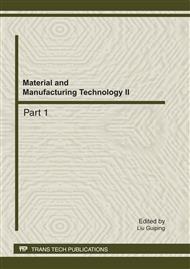[1]
D. Kochan, C. C. Kai, D. Zhaohui, Rapid prototyping issues in the 21st century, Computers in Industry, Vol. 39, 1999, Pages 3-10.
DOI: 10.1016/s0166-3615(98)00125-0
Google Scholar
[2]
A. Rosochowski, A. Matuszak, Rapid tooling: the state of the art, Journal of Materials Processing Technology, Vol. 106, 2000, Pages 191-198.
DOI: 10.1016/s0924-0136(00)00613-0
Google Scholar
[3]
H. C. Zhang, T. C. Kuo, H. Lu, S. H. Huang, Environmentally conscious design and manufacturing: A state-of-the-art survey, Journal of Manufacturing Systems, Vol. 16, Issue 5, 1997, Pages 352-371.
DOI: 10.1016/s0278-6125(97)88465-8
Google Scholar
[4]
X. C. Tan, F. Liu, H. J. Cao, H. Zhang, decision-making framework model of cutting fluid selection for green manufacturing and a case study, Journal of Materials Processing Technology, Vol. 129, 2002, Pages 467-470.
DOI: 10.1016/s0924-0136(02)00614-3
Google Scholar
[5]
J. Hur, K. Lee, Z. Hu, J. Kim, Hybrid rapid prototyping system using machining and deposition, Computer-Aided Design, Vol. 34, 2002, Pages 741-754.
DOI: 10.1016/s0010-4485(01)00203-2
Google Scholar
[6]
D. King, T. Tansey, Alternative materials for rapid tooling, Journal of Materials Processing Technology, Vol. 121, 2002, Pages 313-317.
DOI: 10.1016/s0924-0136(01)01145-1
Google Scholar
[7]
J. C. Ferreira, A. Mateus, Studies of rapid soft tooling with conformal cooling channels for plastic injection moulding, Journal of Materials Processing Technology, Vol. 142, 2003, Pages 508-516.
DOI: 10.1016/s0924-0136(03)00650-2
Google Scholar
[8]
M. Pinto, A. D. Santos, P. Teixeira, P.J. Bolt, Study on the usability and robustness of polymer and wood materials for tooling in sheet metal forming, Journal of Materials Processing Technology, Vol. 202, 2008, Pages 47-53.
DOI: 10.1016/j.jmatprotec.2007.08.082
Google Scholar
[9]
D. King, T. Tansey, Rapid tooling: selective laser sintering injection tooling, Journal of Materials Processing Technology, Vol. 132, 2003, Pages 42-48.
DOI: 10.1016/s0924-0136(02)00257-1
Google Scholar
[10]
B. O. Donnchadha, A. Tansey, A note on rapid metal composite tooling by selective laser sintering, Journal of Materials Processing Technology, Vol. 153, 2004, Pages 28-34.
DOI: 10.1016/j.jmatprotec.2004.04.034
Google Scholar
[11]
S. Ma, I. Gibson, G. Balaji, Q.J. Hu , Development of epoxy matrix composites for rapid tooling applications , Journal of Materials Processing Technology, Vol. 192-193, 2007, Pages 75-82.
DOI: 10.1016/j.jmatprotec.2007.04.086
Google Scholar
[12]
P. V. Vasconcelos, F. J. Lino, A. M. Baptista, Rui J.L. Neto, Tribological behaviour of epoxy based composites for rapid tooling , Wear, Vol. 260, Issues 1-2, 2006, Pages 30-39.
DOI: 10.1016/j.wear.2004.12.030
Google Scholar
[13]
P.V. Vasconcelos, F.J. Lino, A. Magalhaes, R.J.L. Neto, Impact fracture study of epoxy-based composites with aluminium particles and milled fibres , Journal of Materials Processing Technology, Vol. 170, Issues 1-2, 2005, Pages 277-283.
DOI: 10.1016/j.jmatprotec.2005.05.006
Google Scholar
[14]
H. Durr, R. Pilz, N. S. Eleser, Rapid tooling of EDM electrodes by means of selective laser sintering, Computers in Industry, Vol. 39, 1999, Pages 35-45.
DOI: 10.1016/s0166-3615(98)00123-7
Google Scholar
[15]
A. Simchi, F. Petzoldt, H. Pohl, On the development of direct metal laser sintering for rapid tooling, Journal of Materials Processing Technology, Vol. 141, 2003, Pages 319-328.
DOI: 10.1016/s0924-0136(03)00283-8
Google Scholar
[16]
Environmentally Conscious Manufacturing, National Science Foundation program guideline, May (1995).
Google Scholar
[17]
S. Rahmati, M. Reza Rezaei, J. Akbari, Design and Manufacture of a Wax Injection Tool for Investment Casting Using Rapid Tooling , Tsinghua Science & Technology, Vol. 14, Supplement 1, 2009, Pages 108-115.
DOI: 10.1016/s1007-0214(09)70076-8
Google Scholar
[18]
C.G. Li, C.L. Li, Plastic injection mould cooling system design by the configuration space method , "Computer-Aided Design, Vol. 40, Issue 3, 2008, Pages 334-349.
DOI: 10.1016/j.cad.2007.11.010
Google Scholar
[19]
D.E. Dimla, M. Camilotto, F. Miani, Design and optimisation of conformal cooling channels in injection moulding tools, Journal of Materials Processing Technology, Vol. 164-165, 2005, Pages 1294-1300.
DOI: 10.1016/j.jmatprotec.2005.02.162
Google Scholar
[20]
R. C. Luo; Z. W. Li; M. H. Li, Measurement and estimation of temperature distribution inside core and cavity of the mold using virtual micro sensors , Proceeding of IEEE International Conference on Multisensor Fusion and Integrated for Intelligent Systems, Seoul, Korea, August 20-22, 2008, Pages 278-283.
DOI: 10.1109/mfi.2008.4648078
Google Scholar


